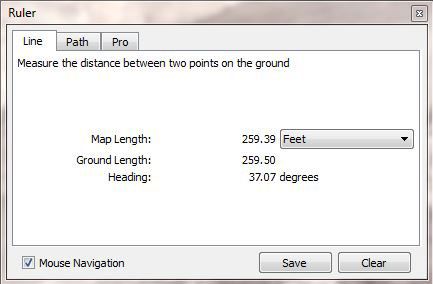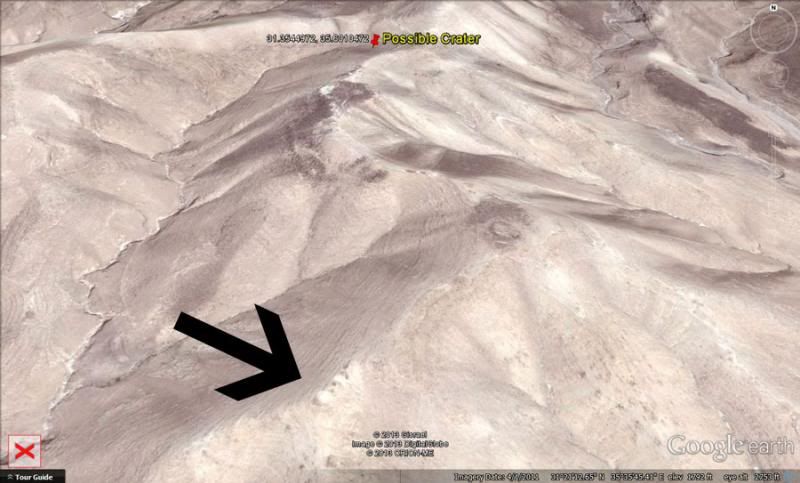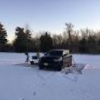
Metorite impact on a salt flat
#1

Posted 26 March 2013 - 07:40 PM
As an example, suppose we have a smaller meteorite about 1.3 meters wide leaving a crater with diameter of 45 meters & depth of 16 meters into the bedrock of a desert environment...based on Kamil Crater in Egypt. However, our scenario calls for a similar meteorite striking a salt flat which is more than a kilometer deep.
1. Given that the impacted material in our scenario is compacted salt, would you expect the resulting crater to be similar, larger or smaller than Kamil Crater?
2. Do you think the ejected salt chunks would be on fire (or hot enough to ignite other materials) when they hit the ground?
3. Could you give a rough estimate for how far you would expect the ejecta to travel? I know this might vary based on angle of impact & whatnot but a ball park figure is all I'm looking for.
4. I know that certain types of meteorites may leave stones or crystals of a green color within the surviving debris. Would this still be a possibility if our meteorite hit a salt flat?
5. Would the answers to these questions vary based on whether the salt flat was exposed or covered in, say, 10 meters of water? If so, how would the water change things?
Please humor me...this is a serious inquiry and I'm not sure where else to go with this. Thanks!
#2

Posted 26 March 2013 - 09:31 PM
Something tells me that your question is not just rhetorical. What is the rest of the story, are you writing a novel where this occurs? Have you seen a structure like the one you describe? Please give us some more info>
Thanks,
Peter
#3

Posted 26 March 2013 - 11:28 PM
Edit:
The sulfur may have already been present in the ground at impact...not sure about the sulfur coming with the meteor.
#4

Posted 26 March 2013 - 11:54 PM
22° 01 min 06 sec N 26° 05 min 16 sec E -- change to the proper double & single quote marks though...i couldn't get this forum to display them properly.
And for a relative size reference, here is a LINK to a photo of Kamil Crater with people standing on the rim to the right in the photo. It's kind of out-of-whack but you get the picture. Keep in mind the crater is partially filled with sand.
#5

Posted 27 March 2013 - 04:54 PM
I believe this particular incident is in regard to the end of a period known as the Early Bronze Age (in the Near East), which came to an end around 2000 B.C. (give or take). It is difficult to establish an exact date for individual events at this time but an overall view can be discerned from available evidence. It is very apparent that there was a general decline of civilizations across the known world at this time...in fact, the evidence indicates it was probably a world-wide period of decline. There are also numerous momentous events that occurred in this time period which resulted in (or from) an overall large-scale breakdown of society which I can partially outline for you:
1. Writing developed to the degree of sophistication necessary to record epic stories & some religious texts. For example, the stories of Gilgamesh were first written down around this time.
2. The fall of Troy in western Turkey (Troy II)
3. The end of the Old Kingdom in Egypt
4. The fall of the Akkadian Empire in Mesopotamia
5. Utter destruction of archaeological sites in certain areas of the Middle East that remain unexplained.
6. The Archaic Stage of the American Archaic Period ended in North/South America.
Archaeologists are unable to come to an agreement regarding the root cause of this general malaise. They are simply unable to find enough in the archaeological record of any one place to form a universal conclusion.
However, after conducting much research into the available records of numerous ancient cultures, I decided to look for evidence that a cataclysm occurred in which the earth was struck not by just a single meteorite, but by numerous pieces of something...either a larger meteor or a comet that broke up, or maybe a cluster of small meteors.
When I actually looked at these ancient records with this in mind, I began to see attempts to explain (or just talk about) this natural disaster. For example, I found a papyrus from Ancient Egypt with a story on it that led me to believe it may be describing the discovery of the aftermath of an impact site.
There is a lot of information you have to sort through, though. It's like making liquor. You have to distill the information to get at the grain of truth underlying what these people wrote down. When reading a religious text describing a culture's history, you have to filter out the supernatural elements. Sometimes, you can compare the account with the records of another associated culture to get a different side of the story. There are times when you find that a culture may have skipped 500 years of history without making this clear in the text because they wanted to blot out the memory of certain periods. You really have to learn how to read between the lines.
Ancient history is typically studied as separate threads...like Greek history or Egyptian history. The trick is to learn how to recognize where these threads intersect. It isn't always very apparent...in fact, sometimes, ancient cultures went to great lengths to hide their associations from later generations. However, if you do enough comparisons between these separate lines of inquiry, it begins to become possible for you to weave a tapestry.
As for this multiple-impact theory, it's still up in the air. I am nearly certain that there was at least one impact. However, I suspect, for a variety of reasons related to my research, that the impacts were numerous and many of them were relatively small. I am asking you guys these questions here so I can determine how to direct my next line of inquiry. I have already found a number of confirmed and suspected impact sites that seem to fit the general profile, though I still need to research these sites separately where possible. Additionally I believe there is at least one impact, and possibly several, that may not have been realized yet and warrants further investigation.
#6

Posted 27 March 2013 - 05:08 PM
I have never heard of any large (over 10mm) spherical rocks associated with an impact site. Larger (10 cm) roundish rocks created by impacts tend to be found 100s or even a thousand miles from the impact site. I would say that the odds are very small that the large roundish rock that you describe are related to any impact.
Thanks,
Peter
#7

Posted 27 March 2013 - 05:36 PM
#8

Posted 27 March 2013 - 05:47 PM
I am unaware of any meteorite impact on a salt flat. I can only speak in general terms. First I think the the meteorite you propose is too small to make the crater you describe. My guess is that the meteorite should be 3 times the size. The heat is release at the moment of impact. I would think that any fires would be ignited by the impact, any thing that could burn would already be on fire before Fallbak/ejecta could ignite it.
Thanks,
Peter
#9

Posted 27 March 2013 - 07:38 PM
Hi. I am conducting some research on a meteorite impact scenario. I know this forum is filled with scientific geniuses so here's to hoping we have a resident expert (amateur or otherwise) who can shed light on a few things for me.
As an example, suppose we have a smaller meteorite about 1.3 meters wide leaving a crater with diameter of 45 meters & depth of 16 meters into the bedrock of a desert environment...based on Kamil Crater in Egypt. However, our scenario calls for a similar meteorite striking a salt flat which is more than a kilometer deep.
1. Given that the impacted material in our scenario is compacted salt, would you expect the resulting crater to be similar, larger or smaller than Kamil Crater?
2. Do you think the ejected salt chunks would be on fire (or hot enough to ignite other materials) when they hit the ground?
3. Could you give a rough estimate for how far you would expect the ejecta to travel? I know this might vary based on angle of impact & whatnot but a ball park figure is all I'm looking for.
4. I know that certain types of meteorites may leave stones or crystals of a green color within the surviving debris. Would this still be a possibility if our meteorite hit a salt flat?
5. Would the answers to these questions vary based on whether the salt flat was exposed or covered in, say, 10 meters of water? If so, how would the water change things?
Please humor me...this is a serious inquiry and I'm not sure where else to go with this. Thanks!
A 1.6 m (8 tonne) iron meteor hits the ground at 2.2-3.3 km/sec, which is fast enough to have the kinetic energy equal to a similar weight of high explosive. So this is similar to a WWII era blockbuster "earthquake bomb", perhaps a little larger. Try this query in Google Maps to see one such: "54.186029,7.878935".
1. A salt bed would be similar to sedimentary rock (it is, as a matter fact, sedimentary rock).
2. No. The meteor fragments themselves would be hot, but the ejecta (which outweighs the meteor by more than 1000-to-1) would be unaffected in temperature.
3. Hundreds of meters.
4. No. This is an iron meteorite. It will give pieces of iron.
5. Yes 10 meters of water would change the situation dramatically. There would be a big splash, and a much shallower underwater crater. The iron would be cooled immediately by the water. Little, if any, ejecta other than water.
#10

Posted 27 March 2013 - 08:00 PM
#11

Posted 27 March 2013 - 08:25 PM
A 1.6 m (8 tonne) iron meteor hits the ground at 2.2-3.3 km/sec, which is fast enough to have the kinetic energy equal to a similar weight of high explosive. So this is similar to a WWII era blockbuster "earthquake bomb", perhaps a little larger. Try this query in Google Maps to see one such: "54.186029,7.878935".
1. A salt bed would be similar to sedimentary rock (it is, as a matter fact, sedimentary rock).
2. No. The meteor fragments themselves would be hot, but the ejecta (which outweighs the meteor by more than 1000-to-1) would be unaffected in temperature.
3. Hundreds of meters.
4. No. This is an iron meteorite. It will give pieces of iron.
5. Yes 10 meters of water would change the situation dramatically. There would be a big splash, and a much shallower underwater crater. The iron would be cooled immediately by the water. Little, if any, ejecta other than water.
A shallow, underwater crater, that's interesting. Thank you...this is very helpful. I hope you will continue to humor me here. Now, suppose that, instead of being purely a salt flat, the meteor struck an area of large & very shallow (or surface) bitumen deposits. Would you expect a meteor to ignite an explosion of this material, considering the volatile substances mixed within it? And, if there were an explosion, what would you expect a crater, if any, to look like in comparison to Kamil Crater? Again, I am curious about a meteor of the same proportions as in the previous example.
#12

Posted 27 March 2013 - 09:30 PM
I am afraid that you are constructing a house of cards. For example we still don't know what type of impactor that we are talking about. I assumed a stoney meteorite that left behind green crystals. You didn't say anything about iron being present. Carysub assumed that the meteorite was iron since that is the type most likely to make a small crater.
Tell us everything, I think that you are still holding back info. Are you talking about an actual feature or is this a hypothetical feature?
Thanks,
Peter
#13

Posted 28 March 2013 - 06:11 AM
For the Bronze Age (3300 to 1100 BC according to the generally accepted Near Eastern chronology), I confined myself to records created before 30 A.D. I started with Ancient Egypt because of the vast amount of material that survives. Most of that material is also in the public domain and easily accessible. I reviewed probably thousands of translations of tomb inscriptions, papyri, monuments, stele...all kinds of stuff. Egypt had diplomatic contacts ranging from friendship to warfare with just about everybody in most of the Middle East for 3500 years. Therefore, it wasn't that difficult to follow nodes to whatever surviving records there are to the other sophisticated cultures of this time period and then on to less-sophisticated cultures in Asia, Europe & the Americas...kind of like hopscotch.
As part of all this, I have also examined the Torah (as it was written down around 550 B.C.) in great detail over the last several years. Quite frankly, it took me a long time to learn how to read it. In Sunday School, you're taught it's literal truth but then science and the only objective history people want to teach tells you that it's mostly a fable.
At the beginning, I really didn't see how I could possibly reconcile the Old Testament with an objective study of history. However, over time, I was utterly amazed when I would find that something the Bible said really happened...and I knew it happened because the people or events were attested to in the archaeological record. Of course, there were times where I found things that didn't make sense. As an example, the Book of Genesis claims the Philistines existed in the time of the Patriarchs. However, this is simply not the case as the Philistines are attested to in both written Egyptian records and archaeology, but not until their arrival around 1250BC (or so). Since the story was simply a retelling of an event that already occurred with the Egyptians in an earlier chapter, I simply disregarded it for the purposes of my examination. That's the kind of thing I mean when I said you have to distill the information.
However, you also have to learn how to read the Old Testament. For one thing, it exhibits several huge gaps in history without telling you that. It just goes to the next part still talking about the same character like it happened the next day. Also, you have to realize that it has to do many things at the same time. Therefore, a single story of everything is going to have to convey, well, everything...not only what we think of as subjects like history and whatever they thought they knew of science, but also practical concepts like animal husbandry, building techniques, and planting season. However, when a society has few resources to make a recording of anything, 95% of what does get made will be related to the religion. This is true for most of the ancient records that remain from just about any culture during this period. Therefore, almost everything is couched in religious terms. All the supernatural things need to be filtered out as well.
Additionally, if you were an ancient writer who had to write down the record of an event that occurred slowly over many generations, you are probably going to minimize the number of characters as much as possible by consolidating the story into a single character, as opposed to a succession from the first guy, then to his son, grandson, great-grandson, etc. This consolidation of people gets worse the closer you get back to the beginning of Genesis. For example, the sons of Noah aren't really Ham, Shem, & Jephath...they are dark-skinned people, semites (mid-tone), and light-skinned people of the north. As a further example, the names of Ham's children are actually the names of countries where dark-skinned people lived at the time (Mizraim is Egypt in Hebrew, Put is what the Egyptians knew as Punt south of them, [K]ush, etc.).
Next thing you know, you have recorded something like a large-scale westward migration of Semitic people personified in the character of Abraham. That's why we can't find a record of Abraham. However, we can certainly see migrations of these Semitic people attested to in the historical record. What it all boils down to is this: the Torah really is largely filled with literal truth, after a fashion. I have found myself stunned to find certain things attested to in the archaeological record. After you understand this, it really isn't all that difficult to link many of the events depicted with corresponding events or time periods in the historical record. I could cite numerous other examples for this concept but that really would take a book and this isn't the right venue for that.
Now, this brings us to the issue at hand. What happened at the end of the Early Bronze Age? I did not start out with this line of inquiry in mind. However, the available evidence has presented a problem as there is no consensus over what happened. You see, it wasn't only all the other things I mentioned earlier that occurred. There are ancient records (stele, papyri, etc.) that tell stories of things you could associate with an impact event. By stories, I mean they talk about things like the sun was blocked out and all the crops died causing a long famine or the sun was dimmed by perpetual clouds or haze for an extended period. The only problem is that there is no apparent large crater that I can find to explain this. It's also possible that it was caused by a volcanic eruption. However, I found hints that something else was at play.
One thing I found was a manuscript called the Westcar Papyrus, of Ancient Egyptian origin. The stories on it were apparently written down in the Middle Kingdom but the characters and stories are set in the Old Kingdom. Obviously, you can't depend on what the Egyptian who wrote it wanted people to get from it. However, the second story tells the tale of a pharoah who gets bored and wants to go boating. Twenty virgins are rounded up to row his boat on a "lake." One of the virgins brushes the oar against her hair and a green stone falls out into the water. I've found a couple of translations of this story and it is translated a little differently in each of them. One says the pharaoh's magician caused the waters of the lake to divide in half creating a lane of dry ground so that he could get the stone. The other says the magician caused the water from half the lake to stack up on top of the water on the other half so that it was twice as deep on that side. Then the pharoah could get the green stone. In each story, the magician then causes the water to go back. I really didn't know what to make of it at first until I found out you could potentially have a green meteorite and I had already thought of the possibility of an impact event for my cataclysm anyway. There weren't a lot of lakes in Egypt but there was one huge lake the Egyptians artifically created in the Old Kingdom (by diverting the Nile) that would still have been there at the proper time. This idea simmered for quite a while for lack of evidence.
In the mean time, I was kind of working backwards through the Torah so Genesis is the last part that received a heavy focus. Through a comparative analysis with what I had been able to find from other cultures, I determined that the destruction of Sodom & Gomorrah also occurred at the end of the Early Bronze Age.
I believe the archaeology may very well sustain an impact theory also. The "Cities of the Plain" are well attested with known ruins around the south basin of the Dead Sea. Around the time in question, the archaeology also shows a destruction in the immediate area. Bab edh Dhra is thought to be Sodom and, a short distance away, Numeira is thought to be Gomorrah. They were both destroyed by conflagration around this time with Gomorrah suffering utter destruction. Sodom has a huge cemetery (compared to other sites) with graves/tombs filled with multiple people. It is unclear how many died at this particular time, though, because the city apparently existed for, like, a 1000 years. If you ask an archaeologist what happened, they will tell you that they have no idea but they "assume" it resulted from either an earthquake or conflict or maybe both. An interesting thing about Numeira is that the people had erected a tower that collapsed on top of people during the event. Archaeologists discovered their bodies 4000 years later.
Now, to the Hebrew. The meaning of the word Sodom in Hebrew is "Burnt" and the meaning of the word Gomorrah is "Heap." Additionally, Sodom and Gomorrah were in or very near the Vale of Siddim, as the Bible explains a couple of chapters earlier. In Hebrew, "Siddim" translates as "Flats." Your Bible probably says, in Genesis 14:10, something along the lines of the Kings of Sodom & Gamorrah fled to the Vale of Siddim and fell in "slime pits." However, the Hebrew can be translated as "bitumen pits" also. Obviously, this potentially leads us to the Vale of "Bitumen Flats" or "Tar Flats."
How about the geology? In 2009, the Geology Society of America issued a report that determined the salt pillar formation on Mount Sedom, historically known as Lot's Wife, was actually formed as a remnant of the cave wall left standing when a salt cave collapsed between 2150 and 1730 B.C. (carbon-dated using material within the collapse). This is also at the correct time, roughly. The report also assumes an earthquake but is clearly making an assumption.
I'm not sure how familiar you are with this region but the Dead Sea basin is the lowest place on earth. The north basin goes down into a deep gash in the crust for hundreds of meters Then there are a couple of kilometers of salt deposit. A cross section of this basin resembles a deep crater with steep sides...in this cross section, the southern basin looks like a big shallow lip to the larger crater. However, the crater under the north basin is at least twice as long as it is wide and, if anything major, I would more likely peg it for a volcanic caldera considering the spot where it's sitting. The south basin is currently separated by a ridged salt formation. The water depth in the south basin is very shallow, currently averaging 6 meters, and the maximum depth of salt deposit is currently 100 meters (not necessarily across the entire basin). Below the salt is a huge crack in the earth's crust serving as the boundary between the Asian & African tectonic plates. There are frequent earthquakes...the sides and floor of the valley frequently move against each other as you can probably imagine. In 2000 B.C., the floor of the south basin was 20 meters higher than it is now. At the time, I imagine it was exposed, at least partially, as our "Vale of Tar Flats" likely sat on top of it. The depth of the salt deposit in the south basin at that time is unknown, but presumably was less than it is now considering that salt has been accumulating for 4000 years since then. As for bitumen, there are still large natural deposits nearby. There are also significant magnetic anomalies but these are thought to result from the geology of the area.
The water is the consistency of a medium to light syrup due to the mineral content. The water level has frequently oscillated by many hundreds of meters over the recent geologic past. It has been much higher than today and much lower. The water has sloshed and settled all over in its basin depending on the then current lay of the land (due to tectonic/earthquake activity) and how much water was present at a given time. A large amount of water may have been lost around 2000 B.C. but I have seen other reports saying the most recent mass water loss occurred closer to 10,000 B.C. so there's a conflict there. Currently the water level is dropping 1 meter per year due to a combination of evaporation and the diversion of water from the Jordan River.
As for craters, there is no apparent large crater caused by a meteor unless you consider the southern basin to be a large shallow crater. However, I have found a number of smaller structures nearby that could possibly be impact sites. However, they need to be investigated more thoroughly as a satellite photo is certainly not definitive.
I am also aware of extremely large (kilometers across) geologic structures called makhtesh that go off in a vector southwest of the Dead Sea. Geologists say they are caused by erosion but they do resemble craters...like some kind of material splashed in a concentrated direction across the landscape from the Dead Sea and caused the eventual erosion of huge crater-like holes in the ground underneath the spots where the splashed material landed. There are 7 known makhtesh in the world...and all 7 in this location...5 in the desert southwest of the Dead Sea and 2 more nearby in the eastern Sinai. I'm not sure of their ages as there doesn't appear to be a lot of available research material for them. If they did represent some sort of splashed material, it's very interesting that their pattern creates a vector pointing back directly to the southern basin of the Dead Sea. This can be seen clearly on a topographic map. It would be interesting to test the rocks inside them as I could find no information for that. I am not suggesting they are involved here, just noting nearby geologic peculiarities. Those big sulfur rock balls are also in the desert southwest of the Dead Sea.
As for what exactly happened here, I don't know but I think it's a very interesting question that surely warrants further investigation. It is also my opinion that this event probably represents the key to understanding what happened around 2000 B.C. I guess the final determination may depend on whether someone can figure out how a meteorite impact would unfold when hitting a soft hot spot filled with bitumen and with a thin crust over some magma. If a meteor can be eliminated as a possibility, I guess all that leaves is an earthquake with a subsequent natural gas explosion. Here's you one last thing to think about:
Genesis
19:24 Then the LORD rained upon Sodom and upon Gomorrah brimstone and fire from the LORD out of heaven;
19:25 And he overthrew those cities, and all the plain, and all the inhabitants of the cities, and that which grew upon the ground.
19:26 But his wife looked back from behind him, and she became a pillar of salt.
19:27 And Abraham gat up early in the morning to the place where he stood before the LORD:
19:28 And he looked toward Sodom and Gomorrah, and toward all the land of the plain, and beheld, and, lo, the smoke of the country went up as the smoke of a furnace.
#14

Posted 28 March 2013 - 06:20 AM
Ordinary chondrite (H5)
One piece of 73.5 g was found on sandy soil. Classification and analysis: olivine Fa19.1, pyroxene Fs17.4Wo0.5; Jürgen Otto, Mineralog. Petrogr. Institut der Universitat, Albert-Strasse 23 b, D79104 Freiburg. Main mass: Swiss Meteorite Laboratory, P.O.Box 126, CH-8750 Glarus, Switzerland.
#15

Posted 28 March 2013 - 12:39 PM
You have an interesting hypothesis. There is some much going on that I can't begin to picture the processes that would happening.
I can give you an educated guess on the meteorite that you mentioned. El Faiyum would be gray to brown, not green.
Thanks,
Peter
#16

Posted 28 March 2013 - 03:15 PM
#17

Posted 09 April 2013 - 07:31 AM
If dry, you could land a C-130 on them without any worries. It was a challenge to make a dent in them with a pick-axe.
If they were wet, it could swallow a tank up to its turret!
Concrete vs. Slime
#18

Posted 10 April 2013 - 10:12 AM
The Salt Flats (Sebkah) that I saw in Saudi Arabia and Iraq could be wet or dry.
If dry, you could land a C-130 on them without any worries. It was a challenge to make a dent in them with a pick-axe.
If they were wet, it could swallow a tank up to its turret!
Concrete vs. Slime
This makes me wonder whether it's possible to scan the surface looking for meteorites buried within the salt layer. I also looked for any research indicating that someone had ever tested the area for unusually high levels of iridium but I was unable to find anything about this. There are a number of ruins surrounding the southern basin where tests could be conducted. It seems clear that there was some sort of natural disaster involving an explosion as there are still pieces of sulfur embedded within the debris of some of these ruins. Of course, this presumes the sulfur flew through the air and embedded itself rather than being scooped up in the molds when the mud bricks were produced.
#19

Posted 10 April 2013 - 01:10 PM
Interesting hypothesis and I have done some thinking along these lines myself over the years, in regards to folklore and meteorites.
More later...
Best regards,
MikeG
#20

Posted 27 April 2013 - 04:40 PM
I also have another question. Follow this LINK to see a photo regarding this question. These large & generally spherical rock balls are all over the ground in an area of this rocky desert. Some of them are huge enough that two people can hug it & touch hands. They are apparently protected by the government because they emit the smell of sulfur when broken open
We have Concretion in shale around here . We called them turtle rocks as kids, In some areas their made of iron sulfide when they are either cut or hammered, they produce sparks and a burning sulfur smell
#21

Posted 05 May 2013 - 06:55 AM
We have Concretion in shale around here . We called them turtle rocks as kids, In some areas their made of iron sulfide when they are either cut or hammered, they produce sparks and a burning sulfur smell
That seems to be consistent with these rocks...probably the same thing. Thank you.
Now, for something else. I've been looking at this geologic feature for a while. Its location is labeled in the top right of the map and you can see that it is very close to the area in question. In Google Earth, you can find it at: 31.3544972, 35.6010472. I can't find any indication that this is a volcanic vent or caldera. Also, just south of it along the ridge, there may be another structure or two but they're only about 50 feet wide. I don't see any other similar structures in the immediate area. Of course, if anything fell into one of those wadis, I imagine it would have washed away by now. From the images below, do you think it's worth somebody going up there to check it out? The 3-D feature of Google Earth doesn't seem to be terribly useful with features this small...I compared with other similar craters and they all seem to look like a flat image when you get to ground level even if there is a depression there.
[Map Correction: Numeira is actually a bit farther north...on that promontory jutting out into the right side of the southern basin.]

A close-up:

Measurement:

Wider view with arrow pointing at small structure(s) to the south:























